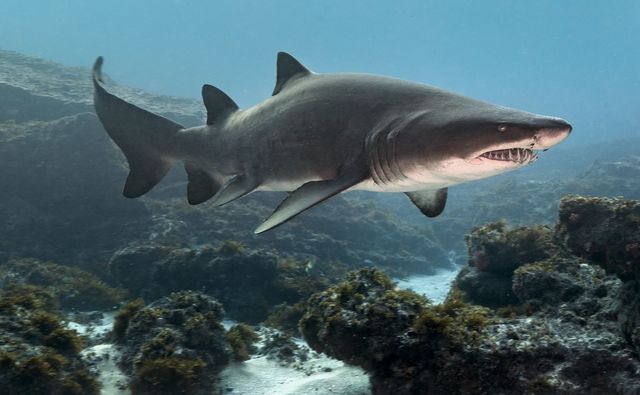Scientists report that the huge shark is the first on record to appear in Irish waters. The behemoth creature was discovered at Kilmore Quey by Swiss tourists out for a walk.
Trinity College Dublin biologist Dr. Nicholas Payne rushed down to Kilmore Quay, in County Wexford when it was reported that a 14ft (4.2m) small-tooth sand tiger shark was spotted washed up on the beach.
Swiss tourists who discovered the shark emailed Dr. Payne to report the sighting. Dr Payne and his team then rushed to the site. The Trinity team included Jenny Bortoluzzi and Haley Dolton, and UCD scientist Kevin Purves
He told the BBC "As soon as I saw the photos, I knew we had to get down there urgently."
"Myself and my team quickly scrambled and drove down to Wexford and we made it just in time as the tide was coming in," he said.
"We had to rush to take as many measures and samples of the animal as possible before the tide took it out."
Sadly the large female fish, weighing between 300 and 400 kg passed away.
The small-tooth sand tiger is the largest of the three sand shark species, commonly measuring about 11.8 feet (3.6 meters) in length. The largest small-tooth sand tigers measure about 4.5 meters (14.8 feet) long and weigh about 289 kg (637 pounds).
While these sharks pose no risk to people they are assessed as "vulnerable" by the International Union for the Conservation of Nature. They face threats unintentional threats from commercial fisheries (bycatch) and from water pollution.
Dr. Payne said, "It's a rare opportunity to have access to this species and to do what we can in terms of learning more information in trying to get something good out of this sad event."
He added, "Even though it was dead, for us to be so close to it and measuring and looking at it - it is still awe-inspiring for us to see those amazing animals - albeit it a little bit sad - that it was not swimming around out there."
Another smalltooth sandtiger shark has washed up, this time in Wexford, Ireland.
Could mean first UK and Ireland records within days of each other + Hampshire most northerly documented sighting for this species for a mere two weeks.
Mind blown.
? Nicholas Payne pic.twitter.com/eoysHReG2d
— Blue Planet Society (@Seasaver) April 2, 2023
Payne did voice concern as another small-tooth sand tiger shark washed up on the southern coast of England, near Plymouth, two weeks ago. It's unusual to see two of these species in such a northerly location in such a short time span.
"If there's any worry to be had it's more probably from the shark's perspective because seeing two animals appear so close together both in space and time - given that they are normally not observed in this region - is a little bit concerning from our point of view as shark biologists and conservationists," he said.
"We're hopeful it's not the start of something or that we are going to see more mortalities in this species."
Dr. Payne told the Irish Independent that this sad result can be studied and return results.
"This would not be a very heavily studied species of shark. We can learn a lot about its general biology from this too – what it was eating and that type of thing. We’re shark nerds, unashamedly so, and we get very excited by opportunities like this. While it’s a bit sad to see a dead animal, we also have to see it as an opportunity to learn as much as we can about them.
"If, for example, it’s established that it’s an unnatural death, we could look to do some things differently and help to feed conservation work.”
Sure does look like Odontaspis ferox. It was a huge 4.3m TL female. We took a LOT of samples to try learn more, including what might have happened to her. Normally a deep-water species so these recent standings a little strange. More to follow pic.twitter.com/yJb6BmYgOm
— Nicholas Payne (@nicklpayne) April 1, 2023
Dr. David Curnick, Head of the Ocean Predator Lab at the Zoological Society of London, is working with the Ireland team to study the co-occurrence of the two shark stranding.
"However, a second individual in quick succession seems more than a coincidence and suggests that these sharks, which are more commonly found in deeper water, may be using UK and Irish waters more readily than we previously thought,” he told The Telegraph.
"Coupling these two new occurrences, which are the most northerly records for the species, with the flurry of recent reports of the species elsewhere, suggest that they may be expanding their range northwards and into more temperate waters.
"Over the coming weeks and months, we will be working closely with our colleagues in Ireland to understand what might be driving these shifts and, hopefully, work out what caused the death of both animals."
The Trinity College Dublin team intends to share their findings with marine biologists in the United Kingdom.




Comments